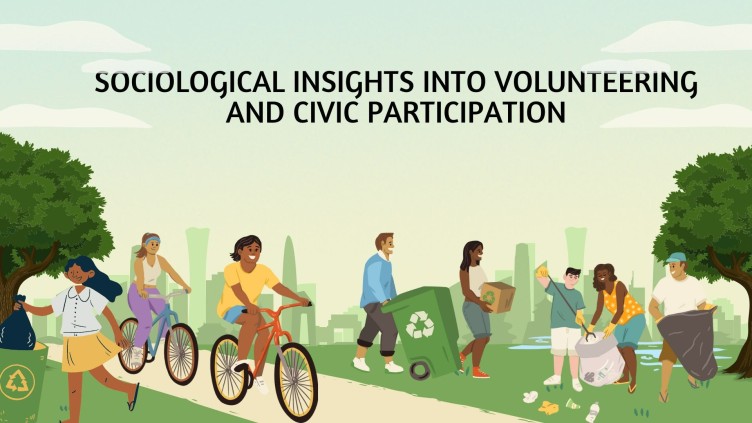Volunteering and civic participation are vital components of a thriving society. These activities not only benefit the community but also enhance the lives of those who engage in them. From strengthening social bonds to fostering a sense of purpose, the sociological implications of volunteering and civic participation are profound. Let’s dive into these insights and understand how these activities shape and are shaped by society.
The Social Fabric of Volunteering
Building Social Capital
Social capital refers to the networks, norms, and social trust that facilitate coordination and cooperation for mutual benefit. Volunteering is a prime example of building social capital. When individuals come together to address community needs, they form connections and trust, which can be leveraged for future collective action.
Example: In response to natural disasters, such as Hurricane Katrina in 2005, communities often see a surge in volunteerism. People from various backgrounds unite to provide relief, rebuild homes, and support affected families. This collective effort not only addresses immediate needs but also strengthens the community’s resilience and trust in one another.
Enhancing Social Integration
Volunteering helps integrate diverse groups into the social fabric. It provides a platform for people of different ages, ethnicities, and socioeconomic backgrounds to work together, fostering understanding and reducing social isolation.
Example: Programs like Habitat for Humanity bring volunteers from all walks of life together to build homes for those in need. This not only provides shelter for families but also promotes social integration as volunteers share experiences and learn from each other.
Civic Participation: A Pillar of Democracy
Empowering Citizens
Civic participation empowers individuals by giving them a voice in the decision-making processes that affect their lives. Engaging in activities such as voting, attending town hall meetings, or participating in protests helps people influence policies and hold leaders accountable.
Example: The 2020 Black Lives Matter protests saw millions of people across the globe participating in demonstrations against racial injustice and police brutality. This civic participation led to significant discussions on policy reforms and increased awareness about systemic racism.
Strengthening Democratic Institutions
Active civic participation is crucial for the health of democratic institutions. When citizens are engaged, they are more likely to trust and support democratic processes, leading to more stable and effective governance.
Example: In countries with high voter turnout, such as Denmark and Sweden, there is a strong correlation between civic engagement and trust in government. These nations often rank high in measures of government effectiveness and public satisfaction.
The Benefits of Volunteering and Civic Participation
Personal Growth and Fulfillment
Engaging in volunteering and civic activities contributes to personal growth and fulfillment. These activities provide opportunities to develop new skills, gain experiences, and find a sense of purpose.
Example: Volunteering at a local food bank can teach organizational and leadership skills, enhance empathy, and provide a sense of accomplishment from helping those in need.
Health Benefits
Research has shown that volunteering can have positive effects on mental and physical health. Regular involvement in volunteer activities is associated with lower levels of depression, increased life satisfaction, and improved physical health.
Example: A study by Carnegie Mellon University found that older adults who volunteered at least 200 hours a year were less likely to develop high blood pressure than those who did not, highlighting the health benefits of staying active and engaged.
Barriers to Participation
Socioeconomic Factors
Despite the benefits, not everyone has equal opportunities to participate in volunteering and civic activities. Socioeconomic factors can create barriers that limit participation.
Example: Low-income individuals may face challenges such as lack of time due to multiple jobs, limited access to transportation, or childcare responsibilities, making it difficult for them to engage in volunteer work or attend civic meetings.
Cultural Differences
Cultural norms and values can also influence volunteering and civic participation. In some cultures, there may be less emphasis on individual volunteerism and more focus on family or community obligations.
Example: In collectivist cultures, such as those in many Asian countries, people may prioritize helping family and community members directly rather than engaging in formal volunteering activities. Understanding these cultural differences is essential for promoting inclusive participation.
The Role of Technology
Facilitating Participation
Technology has transformed the landscape of volunteering and civic engagement. Online platforms and social media make it easier for individuals to find opportunities, connect with others, and mobilize for causes.
Example: Websites like VolunteerMatch and social media platforms enable people to discover volunteer opportunities that fit their interests and schedules. During the COVID-19 pandemic, virtual volunteering became popular, allowing people to contribute from the safety of their homes.
Enhancing Advocacy
Digital tools have also empowered individuals and groups to advocate for change more effectively. Online petitions, crowdfunding, and social media campaigns can amplify voices and rally support for various causes.
Example: The #MeToo movement gained momentum through social media, allowing survivors of sexual harassment and assault to share their stories and call for accountability. This digital advocacy led to widespread public awareness and policy changes.
Encouraging Participation
Education and Awareness
Raising awareness about the benefits and opportunities for volunteering and civic participation is crucial. Educational programs in schools and communities can foster a culture of engagement from a young age.
Example: Schools that incorporate community service into their curriculum help students develop a sense of civic responsibility and the habit of giving back. Programs like AmeriCorps and Teach For America provide structured opportunities for young adults to contribute to society while gaining valuable experience.
Removing Barriers
Addressing the barriers that hinder participation is essential for inclusive engagement. Policies and programs that provide support, such as transportation, childcare, and flexible scheduling, can make it easier for everyone to get involved.
Example: Employers offering paid volunteer leave or flexible work hours encourage employees to participate in community service without sacrificing their income or job security.
Creating Inclusive Spaces
Creating inclusive spaces for participation ensures that all voices are heard and valued. Efforts to engage underrepresented groups and provide platforms for marginalized communities are vital for equitable participation.
Example: Community organizations that focus on engaging minority groups, such as the NAACP or the National Council of La Raza, work to ensure that the specific needs and perspectives of these communities are represented in civic activities.
Conclusion
Volunteering and civic participation are powerful tools for building stronger, more inclusive societies. They foster social capital, empower individuals, strengthen democratic institutions, and provide numerous personal and community benefits. However, to maximize these benefits, it is crucial to address the barriers that limit participation and create opportunities for all individuals to engage. As we navigate the complexities of modern society, the insights from sociology can guide us in fostering a culture of active and inclusive civic engagement. By understanding and promoting the value of volunteering and civic participation, we can work towards a more connected and resilient world.







